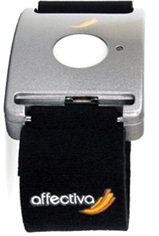 This is ‘electro-dermal activity’ or what used to be called ‘galvanic skin response’ basically a measure of sweat. It is the same technique as used by a lie detector. When you are under stress, when you get a shock or in general at a heightened level of emotion or activity your skin gets more sweaty and skin resistance decreases.
This is ‘electro-dermal activity’ or what used to be called ‘galvanic skin response’ basically a measure of sweat. It is the same technique as used by a lie detector. When you are under stress, when you get a shock or in general at a heightened level of emotion or activity your skin gets more sweaty and skin resistance decreases.The sensor used for this was an Affectiva Q wrist-worn device developed originally by Picard’s Affective Computing group in MIT, then commercialised. Unfortunately it is now out of production, but the Q sensor resources page is still available explaining its operation. The device also measures skin temperature and has three-axis accelerometer.
The sensor is placed on the underside of the wrist, the opposite way round to a wrist watch, and the sensors face the skin. I always wore it on my left wrist.
on one occasion there are two files in one day where I accidentally knocked the device off and then had to start it again
fields:
name – file name
url – dropbox url
sampling_rate – always 8 = samples per second
timeset – ignore files where timeset = false, it means I did something wrong!
start_date – \ ___ date and time when recording starts
start_time – /
offset – always +1 I think this means BST rather than GMT
number_of_samples – number of data samples divide by 8 to get duration in seconds
identical data in JSON format
Each EDA file contains 8 lines of header information followed by data starting at line 9:
data columns:
Z-axis – \
Y-axis – > —- accelerometer data … in principle could get paces from this …
X-axis – /
Battery – battery level – ignore
ÔøΩCelsius – skin temperature in degrees
EDA(uS) – EDA in whatever they measure it in!! bigger means more emotion/stress/sweat
Note this is a CSV export from the raw EDA files produced by the Q sensor.
Extract of CSV meta file
name,url,sampling_rate,timeset,start_date,start_time,offset,number_of_samples 2013_04_18_timeUnset_b.csv,https://dl.dropboxusercontent.com/u/5863079/AlanWalksWales/AffectivQ-CSV/2013_04_18_timeUnset_b.csv,8,,000-00-00,00:00:00,+00,304282 2013_04_18_timeUnset.csv,https://dl.dropboxusercontent.com/u/5863079/AlanWalksWales/AffectivQ-CSV/2013_04_18_timeUnset.csv,8,,000-00-00,00:00:00,+00,405610 2013_04_19.csv,https://dl.dropboxusercontent.com/u/5863079/AlanWalksWales/AffectivQ-CSV/2013_04_19.csv,8,1,2013-04-19,10:03:24,+01,330670 2013_04_20.csv,https://dl.dropboxusercontent.com/u/5863079/AlanWalksWales/AffectivQ-CSV/2013_04_20.csv,8,1,2013-04-20,08:56:21,+01,365140 2013_04_21.csv,https://dl.dropboxusercontent.com/u/5863079/AlanWalksWales/AffectivQ-CSV/2013_04_21.csv,8,1,2013-04-21,10:04:17,+01,301553
Extract of EDA data file (CSV export)
Log File Created by Q Live - (c) 2012 Affectiva Inc. File Version: 1.01 Firmware Version: 1.71 UUID: AQL221200DG Sampling Rate: 8 Start Time: 2013-05-08 09:16:30 Offset:+01 Z-axis | Y-axis | X-axis | Battery | �Celsius | EDA(uS) --------------------------------------------------------- -0.220,0.370,-0.900,-1,22.000,0.032 -0.180,-0.060,-0.850,-1,22.000,0.020 -0.170,-0.040,-0.900,-1,22.000,0.020 -0.160,0.150,-1.340,-1,22.000,0.030 -0.360,0.000,-1.080,-1,22.200,0.034 -0.450,0.530,-0.980,-1,22.000,0.037 0.090,0.440,-0.800,-1,22.000,0.039 -0.320,0.500,-0.850,-1,22.200,0.041 -0.360,0.430,-0.860,-1,22.000,0.041 -0.350,0.640,-0.980,-1,22.200,0.036 -0.410,0.680,-0.730,-1,22.200,0.032 -0.400,0.500,-0.500,-1,22.000,0.032
